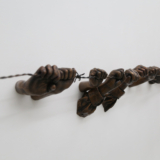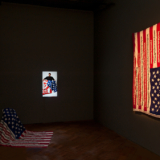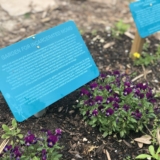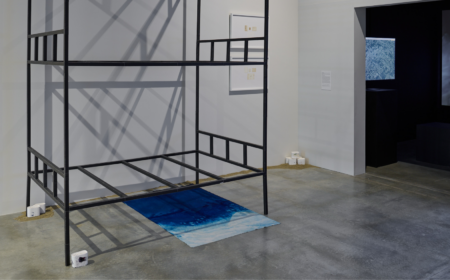Art, Prisons, Policing, and Abolition
With the United States in the midst of a historic reckoning with the systemic racism and inequities of the nation’s criminal legal system, the artists and artworks included in the study guides differently engage with the histories and lived experiences of the carceral system. Through works spanning the visual arts, performance, and music, the artists are part of the growing movement to imagine a world without prisons.
One of the central issues addressed by the artist interviews, discussion questions, and writings which compose the study guides is how artists creatively respond to a question that philosopher, educator, and anti-prison activist Angela Davis asked almost two decades ago: “Why do we take prison for granted?”
As Davis points out, the statistics about incarceration in the U.S. seem like they would have led long ago to a general outcry. The prison population in the nation has soared more than 500% in just forty years, to over two million incarcerated people. This is the largest population in prisons, jails, and juvenile and immigration detention centers in the world.
The racial and ethnic disparities of those incarcerated in the country are stark. Black men are six times as likely to be incarcerated as White men. Hispanic men are 2.7 times as likely. Native American people are incarcerated over twice the rate for White people.
Gender and sexuality also plays a role in the carceral system. One in two Black transgender people has been to prison. While the number of men incarcerated still exceeds the number of women incarcerated, Black women are the fastest growing population in prisons and jails.
In addition to the eye-opening numbers about race, ethnicity, gender, and sexuality, the economic statistics around the prison system also are striking. Fifty-seven percent of men and 72 percent of women in the imprisoned population lived in poverty prior to being arrested, despite a national poverty rate of 11.8 percent.
Yet, despite this data, many people in the United States have remained complacent about discriminations within the criminal legal system. As many of the artists and creative practitioners included in the study guides and interviews featured here attempt to counteract, large swathes of the population—particularly those not directly impacted—have for decades treated prisons and policing, as well as the racial and economic inequalities of the criminal legal system, as normal or even natural.
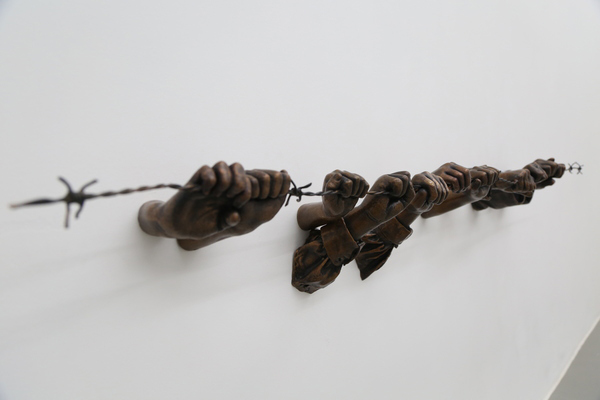
from the “Punctum” series
If the Leader Only Knew
2014
If the Leader Only Knew, part of Hank Willis Thomas’s “Punctum” series of works, offers searing oversight into this dilemma. The bronze sculpture depicting small, child-sized hands grasping barbed wire is derived from imagery found in twentieth-century German publications and archives. The hands have been sourced from a photograph of children held in a concentration camp during the Holocaust.
Cast in bronze and jutting out of the gallery wall, they have, however, been removed from the historical context of Nazism and the racial and ethnic superiority which was used to justify the extermination of millions of people. Without the background of the concentration camp, the hands could be of children in one of the hundreds of U.S. immigrant or juvenile detention centers today, disportionately brown, Black, and American Indian. Or they could be evocative of the millions of other people held in prisons and jails.
If the Leader Only Knew Knew makes reference to the question often asked of leaders and members of society who have historically lived amongst atrocities: Did they know what was happening all around them? Placed in the context of current U.S. affairs, the hands gesture towards the same question in relation to the injustices enacted through the nation’s courts, police departments, prisons, juvenile detention centers, and immigration policies: Living amongst the largest prison population in the world, can anyone claim not to know the impacts and inequities of the carceral system?
Thomas’s sculpture aesthetically recasts this question. With the small, bronze hands creating for viewers an embodied experience of the consequences of this social acceptance, they also give insights into how artists work to denaturalize these systems—creating works that allow people to differently feel and engage with carceral structures and the inequities they contain.
The following study guides are organized around the issues raised by this evocative artwork in regard to the U.S. criminal legal system. We ask:
- What strategies do artists use to engage with the dynamics of how people see and understand prisons and carcerality?
- How do artists attempt to change these perceptions?
Learn More
Cited Sources
Daniel, Roxane
Since You Asked: What Data Exists about Native American People in the Criminal Justice System?
Davis, Angela Y.
Are Prisons Obsolete?
New York: Seven Stories, 2003.
Alexi Jones
Visualizing the unequal treatment of LGBTQ people in the criminal justice system
Prison Policy INitiative
O’Neill Hayes, Tara, and Margaret Barnhorst
Incarceration and Poverty in the United States
American Action Forum, June 30, 2020

